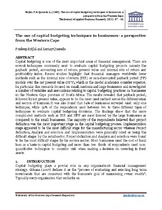| dc.contributor.author | Brijlal, Pradeep | |
| dc.contributor.author | Quesada, Lemay | |
| dc.date.accessioned | 2018-06-07T07:43:45Z | |
| dc.date.available | 2018-06-07T07:43:45Z | |
| dc.date.issued | 2009 | |
| dc.identifier.citation | Brijlal, P. & Quesada, L. (2009). The use of capital budgeting techniques in businesses: a perspective from the Western Cape. The Journal of Applied Business Research, 25(4): 37 – 46. | en_US |
| dc.identifier.issn | 0892-7626 | |
| dc.identifier.uri | http://hdl.handle.net/10566/3786 | |
| dc.description.abstract | Capital budgeting is one of the most important areas of financial management. There are several techniques commonly used to evaluate capital budgeting projects namely the payback period, accounting rate of return, present value and internal rate of return and profitability index. Recent studies highlight that financial managers worldwide favor methods such as the internal rate of return (IRR) or non-discounted payback period (PP) models over the net present value (NPV), which is the model academics consider superior. In particular this research focused on small, medium and large businesses and investigated a number of variables and associations relating to capital budgeting practices in businesses in the Western Cape province of South Africa. The results revealed that payback period, followed by net present value, appears to be the most used method across the different sizes and sectors of business. It was also found that 64% of businesses surveyed used only one technique, while 32% of the respondents used between two to three different types of techniques to evaluate capital budgeting decisions. The findings show that the more complicated methods such as IRR and NPV are most favored by the large businesses as compared to the small businesses. The majority of the respondents believed that project definition was the most important stage in the capital budgeting process. Implementation stage appeared to be the most difficult stage for the manufacturing sector whereas Project definition, Analysis and selection and Implementation were generally rated as being the difficult stages by the retail sector. Project definition and Analysis and selection were found to be the most difficult stages by the service sector. Most businesses used the cost of bank loan as a basis in capital budgeting and more than two thirds of respondents used non-quantitative techniques to consider risk when making a decision on investing in fixed assets. | en_US |
| dc.language.iso | en | en_US |
| dc.publisher | Western Academic Publishers | en_US |
| dc.rights | This is the author-version of the article published online at: https://papers.ssrn.com/sol3/papers.cfm?abstract_id=1259636 | |
| dc.subject | Capital budgeting | en_US |
| dc.subject | NPV | en_US |
| dc.subject | IRR | en_US |
| dc.subject | PP | en_US |
| dc.subject | DCC | en_US |
| dc.title | The use of capital budgeting techniques in businesses: a perspective from the Western Cape | en_US |
| dc.type | Article | en_US |
| dc.privacy.showsubmitter | FALSE | |
| dc.status.ispeerreviewed | TRUE | |

